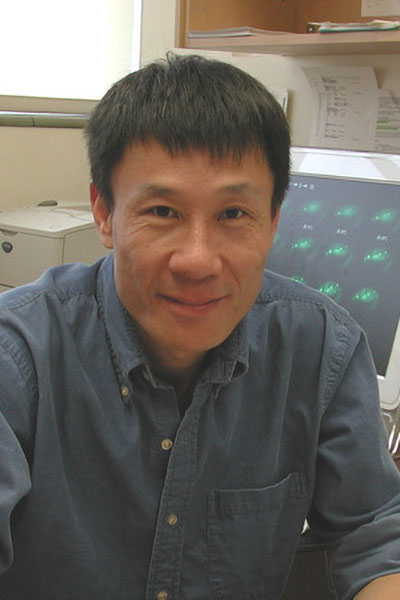
Chentao Chentao_Lin
email: clin@mcdb.ucla.edu
phone: (310) 206-9576
office: 4014 Terasaki Life Science Building
lab website
Research Interests
We are interested in understanding a photosensory receptor called cryptochrome. Cryptochrome is a blue light receptor found in different organisms from a small weed Arabidopsis thaliana to a large animal Homo sapiens. Cryptochrome absorbs blue/UV-A light and it regulates various biological processes including biological clock in animals and flowering time in plants. We choose to work on an Arabidopsis cryptochrome, cry2 (cryptochrome 2), because Arabidopsis is relatively easy to work with. It is also a lot of fun to work with Arabidopsis because its genome has been completely sequenced so that we can use not only molecular genetics and biochemical techniques but also functional genomics approaches to solve our problems. We have found that cry2 regulates Arabidopsis flowering time, and we are trying to figure out how does cry2 do that (namely, what is the signal transduction mechanism of cry2)? We also try to understand how blue-light receptor cryptochromes work together with red-light receptor phytochromes in regulating cell elongation (namely, what is the co-action mechanism of different photoreceptors). You are welcome to come, discuss, or work on these challenge problems. You can also visit our homepage (http://www.mcdb.ucla.edu/Research/Lin/) to get more information about our work.
Selected Publications
Wang, Q., and Lin, C. (2020) Mechanisms of cryptochrome-mediated photoresponses in plants. Annual Review of Plant Biology 71:23.1–23.27.
Liu Q, Su T, He W, Ren H, Liu S, Chen Y, Gao L, Hu X, Lu H, Cao S, Huang Y, Wang X, Wang Q, Lin C. (2020). Photo-oligomerization determines photosensitivity and photoreactivity of plant cryptochromes. Mol Plant. 13, 398–413
Liu, H., Su T., He,W., Wang, Q., and Lin, C. (2019) The universally conserved residues are not universally required for stable protein expression or functions of cryptochromes. Mol. Biol. Evol. 37(2):327-340.
Wang, Q., Liu, Q., Wang, X., Zuo, Z., Oka, Y., and Lin, C. (2018). Beyond the photocycle – how cryptochromes regulate photoresponses in plants? Current Opinion in Plant Biology 45:120–126
Liu, Q., Wang, Q., Deng, W., Wang, X., Piao, M., Cai, D., Li, Y., Barshop, W. D., Yu, X., Liu, B., Oka, Y., Wohlschlegel, J., Zuo, Z., and Lin, C., (2017), Molecular basis for blue light-dependent phosphorylation of Arabidopsis cryptochrome 2, Nature Communications 8: 15234.
Wang, Q., Zuo, Z., Wang, X., Gu, L., Yoshizumi, T., Yang, Z., Yang, L., Liu, Q., Liu, W., Han, Y.-J., Kim, J.-I., Liu, L., Wohlschlegel, J.M., Matsui, M., Oka, Y., and Lin, C. (2016) Photoactivation and inactivation of Arabidopsis cryptochrome 2. Science 354:343-347.
Liu, B., Liu, H., Zhong, D., and Lin, C. (2010) Searching for a photocycle of the cryptochrome photoreceptors. Current Opinion in Plant Biology 13:578–586
Liu, H. Yu, X., Li, K., Klejnot, J., Yang, H., Lisiero, D. and Lin, C. (2008) Photoexcited CRY2 interacts with CIB1 to regulate transcription and floral initiation in Arabidopsis. Science 322: 1535-1539
Lin, C. and Shalitin, D. (2003) Cryptochrome structure and signal transduction. Annu. Rev. Plant Biol. 54: 469-496
Shalitin, D., Yang, H., Mockler, T. C., Maymon, M., Guo, H., Whitelam, G. C., and Lin, C. (2002) Regulation of Arabidopsis cryptochrome 2 by blue light-dependent phosphorylation. Nature 417:763-767
Guo, H., Yang, H., Mockler,T. C., and Lin, C. (1998) Regulation of Flowering Time by Arabidopsis Photoreceptors. Science 279:1360-1363.

